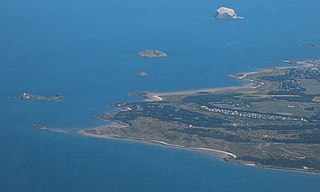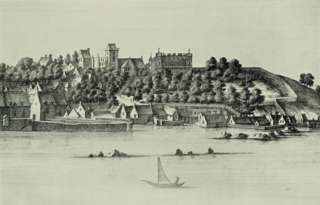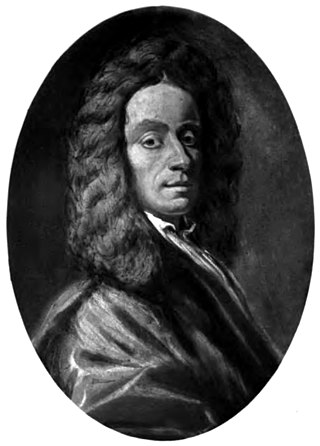
The Bass Rock, or simply the Bass, is an island in the outer part of the Firth of Forth in the east of Scotland. Approximately 2 km (1 mi) offshore, and 5 km (3 mi) north-east of North Berwick, it is a steep-sided volcanic plug, 107 m (351 ft) at its highest point, and is home to a large colony of gannets. The rock is uninhabited, but historically has been settled by an early Christian hermit, and later was the site of an important castle, which after the Commonwealth period was used as a prison. The island belongs to Hew Hamilton-Dalrymple, whose family acquired it in 1706, and before to the Lauder family for almost six centuries. The Bass Rock Lighthouse was constructed on the rock in 1902, and the remains of an ancient chapel survive.

Robert Bennet of Chesters was a 17th-century Scottish gentleman. He lived in the Scottish Borders. Chesters or Grange lies on the banks of the Teviot and is close to the town of Ancrum in Roxburghshire.

Sir George Campbell of Cessnock in Ayrshire was a 17th-century statesman. His lineage was from the Campbells of Loudoun. His father was Sir Hugh Campbell and his mother was Elizabeth Campbell.

Robert Dick of Prestonpans was a 17th-century merchant and inspector of salt works to Lord Carringtoune. He was arrested on 4 September 1676 for attending an open-air service in the Pentland Hills.

William Bell was a field preacher and 17th century minister.

John Dickson was a 17th-century minister from Rutherglen in Scotland. He was a Covenanting field-preacher and a close associate of John Blackadder. For preaching outdoors without a licence he was imprisoned on the Bass Rock from 1 September 1680 to 8 October 1686.

Robert Traill was a church minister at Cranbrook in Kent. He was born at Elie in Fife in 1642. He was incarcerated on the Bass Rock, an island in the Firth of Forth from July 19, 1677 to October 5, 1677. His work was often quoted by J. C. Ryle and is still published in the 21st century.

James Drummond was a seventeenth century Scottish covenanting field preacher. He was imprisoned on Bass Rock for around nine months. At the time of his incarceration his occupation was listed as chaplain to Margaret, Marchioness of Argyll.

Michael Potter was a covenanter. He graduated from Edinburgh on 27 July 1663. He was licensed to preach the gospel in the year 1673. He was a tutor to the family of George, the Laird of Dunglass of that ilk. He was ordained by presbytery for the adherents in the parish of St. Ninians in 1673. He was elected a schoolmaster to Culross by the magistrates. This led to them being summoned before the Privy Council in 1677.
John Rae was the son of William Rae, burgess of Edinburgh. He served heir 7 February 1666. He was educated at the University of Glasgow and graduated with an M.A. in 1651.
John Spreul was a town clerk in Glasgow who was educated at the University of Glasgow, where he completed his Master of Arts degree in 1635. His father was the Provost of Renfrew and an MP for Renfrew. After university, he thought about becoming a church minister but could not, in good conscience, sign the Five Articles of Perth. He was converted after hearing a sermon from David Dickson in 1644. He was a writer which is a Scottish term for a lawyer. For example William Lin is described as a Writer to the Signet which would make him a senior lawyer. He became unpopular with some Glaswegian magistrates because of his opposition to Hugh Binning. According to rumours, he potentially fought for the Covenanters at the Battle of Kilsyth. Spreul and John Graham fought together at the Battle of Philiphaugh in September 1645. Spreul became town clerk of Glasgow on 21 October 1645. He fought for the Scottish Covenanters in the Battle of Dunbar. He is reported to have had a very long beard and to have been mocked for it before the Privy Council of Scotland.

John Spreul or Bass John worked as an apothecary in Glasgow. He got his nickname for being imprisoned on the Bass Rock for around six years on the charge of being present at outdoor religious meetings. Some 17th century church services were attended by armed defensive militia since the regime sent soldiers who attacked those at unauthorised meetings. A verdict of not proven was returned on charges that he supported those defeated at Bothwell Bridge and despite being tortured, twice, using the boot confessed no wrong-doing. Spreul's wife died while he was in prison and he petitioned for his full release, rather than being sent to the American plantations as a slave, when in 1686 there were some concessions from the regime. Spreul was liberated but initially refused to leave since the release order contained statements which he regarded as falsehoods. After freedom, he seems to have quickly gained prominence and became a successful businessman being involved in fish processing and pearl trading. In 1696, he led a national fund-raising campaign to buy back Scots captured by Barbary pirates. He was an author, writing on the trade between Scotland and England, and became a supporter of the Darien Scheme. Spreul was elected as a burgess in 17 Scottish towns in the late 17th and early 18th centuries.

Alexander Dunbar was a Covenanting field preacher and school teacher. He was imprisoned on the Bass Rock for about a year between 1685 and 1686.

James Fithie was a chaplain at Trinity Hospital in Edinburgh. He was imprisoned on the Bass Rock for about a year between 1685 and 1686.

John Greig was a Presbyterian minister from Scotland.

Peter Kid was a 17th-century Presbyterian minister. He was possibly a native of Fife.

John Law (1632–1712) was a 17th-century Presbyterian minister from Scotland. He became Moderator of the General Assembly in 1694 and later was a prisoner on the Bass Rock.
Thomas Ross of Nether Pitkerrie, was born about 1614. He was the son of George Ross of Nether Pitkerrie. He continued in Kincardine after the establishment of prelacy and owes his leaving to a meeting with John M'Gilligan.
Robert Ross was a Presbyterian preacher. He did not have a government licence to preach. He was apprehended at Leith and sent to the Bass Rock. He was kept in confinement there for upwards of three months from April 4-July 19, 1679.
William Spence was a Scottish schoolmaster in Fife. In the month of May 1685, he was summoned to appear before the Privy Council. Phillimore says he "had committed the offence of teaching his pupils the doctrines of Presbyterianism, and attending the forbidden conventicles." Dickson says he "was committed to the Bass where he remained for more than a year, when he petitioned for his liberty on the ground of ill-health." He was sent to the Bass Rock at the same time as Peter Kid and had fourteen months of imprisonment. On the 20th of July 1686, “My Lords ” agreed to his release “upon his finding caution to compear before the Council, when cited; and, in the meantime, to live peaceably and not to keep a school, under a penalty of five thousand merks, Scots money, in case of failure.” He was liberated along with John Greg. After he was set free he had to periodically reappear before the Council to retain his liberty.















